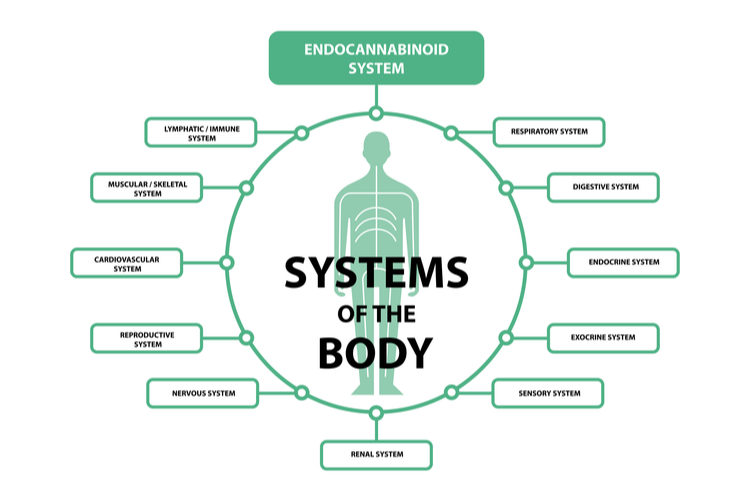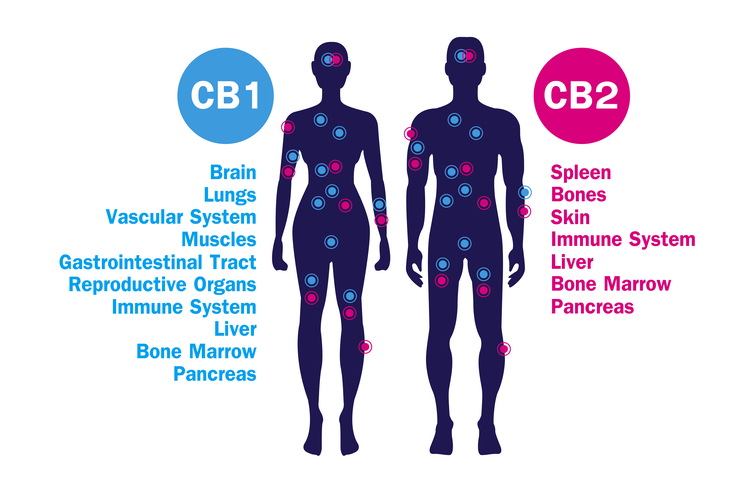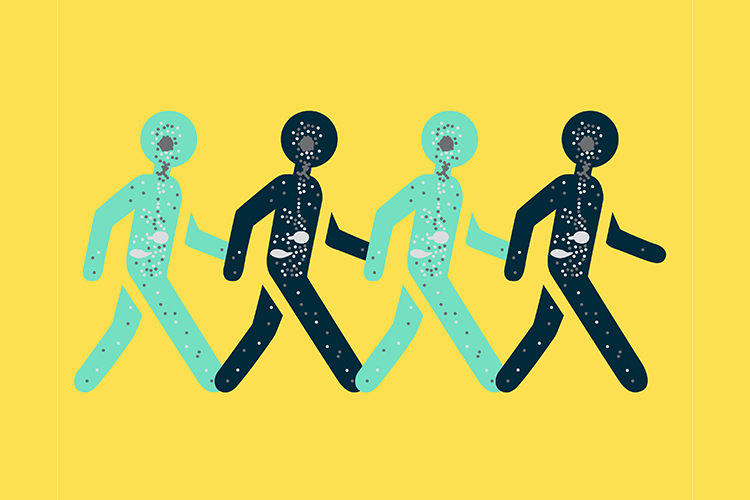It seems like cannabis is being recommended for just about everything these days. It can help you sleep, boost your mood, and ease aches and pains. How can one plant work in so many different ways? The search for this answer led scientists to a major discovery of a previously unknown system, an important component of health and balance in humans and animals: the endocannabinoid system (ECS).
Scientists are just beginning to uncover everything the ECS does for our bodies to keep us healthy, but what we know so far is impressive. In this article, we’ll go over the basics of the human endocannabinoid system and everything it does for your body.
What Is the ECS System?

The endocannabinoid system is made up of three main components:
- Endocannabinoids (cannabinoid-like compounds that are produced naturally by the human body)
- Enzymes that create and destroy cannabinoids
- Cell receptors that receive cannabinoids
Endocannabinoids are the molecules that act in a similar way to phytocannabinoids (plant-derived cannabinoids) like THC. Both endo- and phytocannabinoids interact with cannabinoid receptors, known as CB1 and CB2. These receptors, also known as endocannabinoid receptors, are found throughout the body in the brain, connective tissues, organs, immune cells, and glands.
Even though the endocannabinoid system performs different tasks in each tissue, the goal is always to maintain homeostasis. It’s a bridge between the body and the mind, and it works to maintain a stable internal environment during the fluctuations your systems experience.
How Does the Endocannabinoid System Function?

The body produces endocannabinoids in response to the needs of the physiological systems that regulate processes of the body and the mind. The two major endocannabinoids produced in the body are Anandamide (AEA) and 2-arachidonoylglycerol (2-AG).
When something happens that throws-off homeostasis, like illness or injury, the human endocannabinoid system activates and responds by creating endocannabinoids. They are picked up by cannabinoid receptors to transmit information that activates a physiological response. By binding to receptors, endocannabinoids trigger the release of chemicals that affect things like immune response, appetite, temperature regulations, pain sensations, and much more.
Cannabis and the Endocannabinoid System

When the body’s endocannabinoid system is depleted, plant compounds can work as substitutes to help supplement and promote balance in the body. One of the best ways to substitute a lack of endocannabinoids is to introduce plant cannabinoids — the amazing compounds that are unique to the cannabis plant.
The most popular cannabinoid is delta-9 THC. It has a powerful action on the human endocannabinoid system and provides the well-known some of the well-known effects of cannabis. While THC is the most studied cannabinoid to date, there are dozens of cannabinoids with positive health benefits that scientists are beginning to uncover. Currently gaining the most popularity is the non-intoxicating CBD, which can provide a slew of health benefits without the intoxicating effects of THC.
How Does CBD Interact With the ECS?
Not all cannabinoids interact with the endocannabinoid system in the same way. THC, for example, is a CB1 and CB2 agonist, with an especially high binding affinity for CB1 receptors (this interaction is believed to be primarily responsible for its psychoactive properties).
When it comes to the endocannabinoid system and CBD, things aren’t as straightforward. That’s because, unlike THC, CBD does not appear to have very much binding affinity for CB1 and CB2 endocannabinoid receptors. In fact, research indicates that CBD acts as an antagonist on these receptors, reducing their ability to bind to THC. This may explain why so many people feel like ingesting CBD and THC at the same time mitigates some of the psychoactive effects usually produced by THC and results in a milder high.
Another link between the endocannabinoid system and CBD lies in its effects on the breakdown of endocannabinoids. Research indicates that CBD can inhibit the breakdown of anadamide, leading to higher levels of the endocannabioid after consumption.
Furthermore, CBD is also believed to modulate several non-cannabinoid receptors and ion channels. For example, CBD is believed to interact with 5-HT1A serotonin receptors and TRPV1 receptors–two receptors thought to be involved in a range of biological and neurological processes. While 5-HT1A receptors have been implicated in things like appetite, sleep, and anxiety, TRPV receptors are believed to mediate inflammation, body temperature, and pain perception. In addition to acting like an agonist on these receptors, CBD is also believed to act as an antagonist on GPR55 receptors–another type of G protein-coupled receptor that is widely expressed in the brain.
Terpenes and the ECS
Cannabinoids are far from the only compound of value in the cannabis plant. Terpenes are hydrocarbon compounds that are responsible for giving plants like cannabis their signature smell and aroma. Cannabis is full of a variety of different terpenes which also exist in many common herbs, vegetables, and fruits.
For a long time it was believed that aroma was that only benefit that terpenes provided. But more recently, it’s been suggested that they may also influence the effects of cannabis as part of a phenomenon called the entourage effect. The entourage effect suggests that the many compounds in cannabis, including terpenes and cannabinoids, may work together in synergy to produce the overall effects of cannabis.
Whether or not the entourage theory is true, and regardless of the exact role that terpenes may play in it, one thing is pretty much known for sure–they don’t work like cannabinoids do. In fact, research exists to suggest that at least some if not all, major terpenes in cannabis do not interact with CB1 and CB2 receptors. The only exception to this among the major terpenes was caryophyllene–a terpene that shows a unique, yet low, binding affinity for CB2 receptors.
Final Thoughts
The regular intake of cannabis may help supplement your natural endocannabinoid supply and help you maintain overall health and wellness. It can also deliver targeted symptom relief for a variety of conditions. If you’d like to learn more about what cannabis can do for you, we’d love to help. Our knowledgeable staff at your local Green Goods is available to answer all your questions and recommend products that are right for you.
